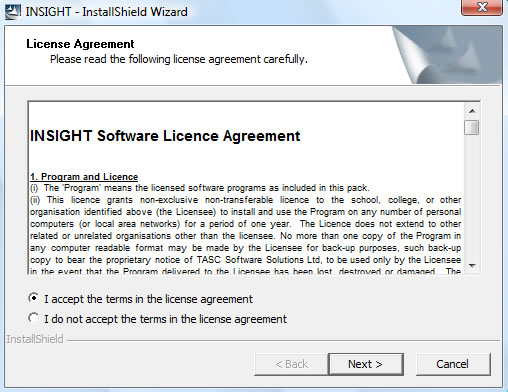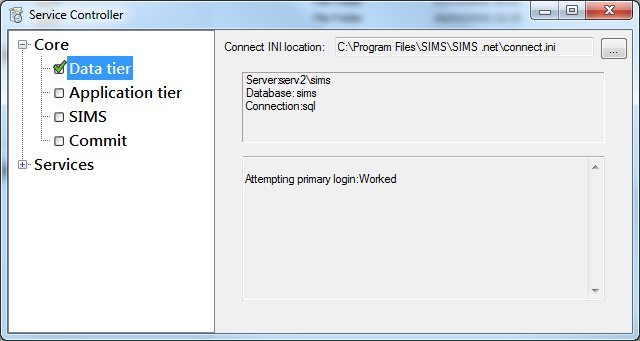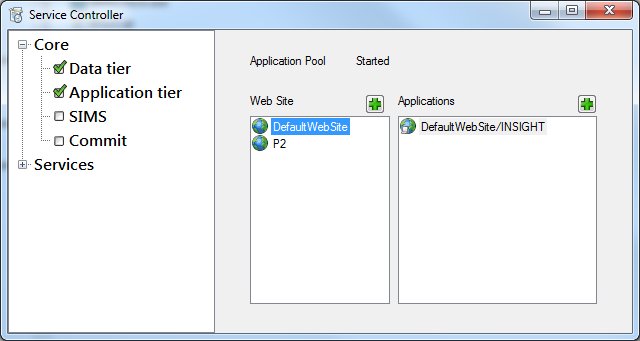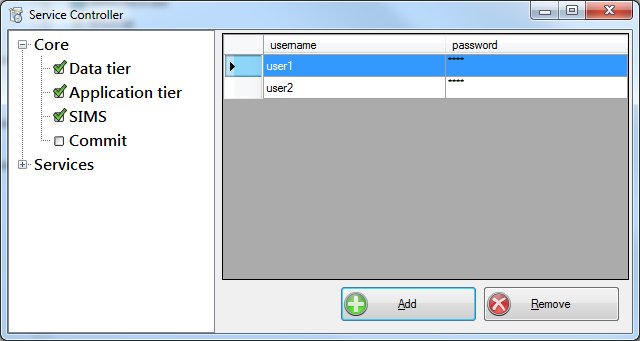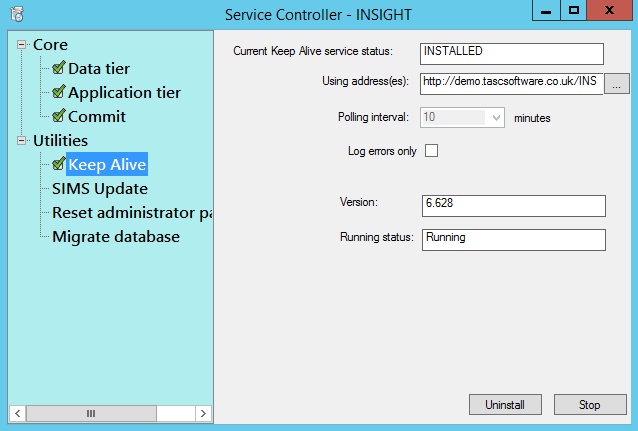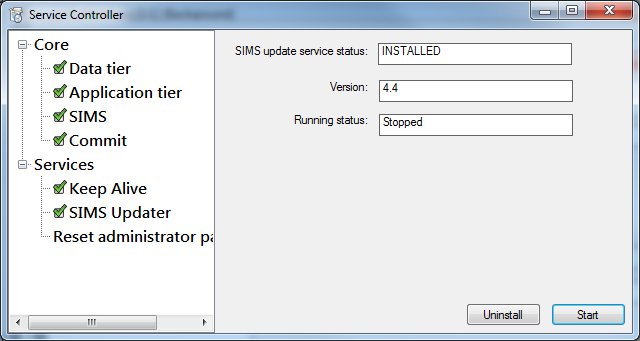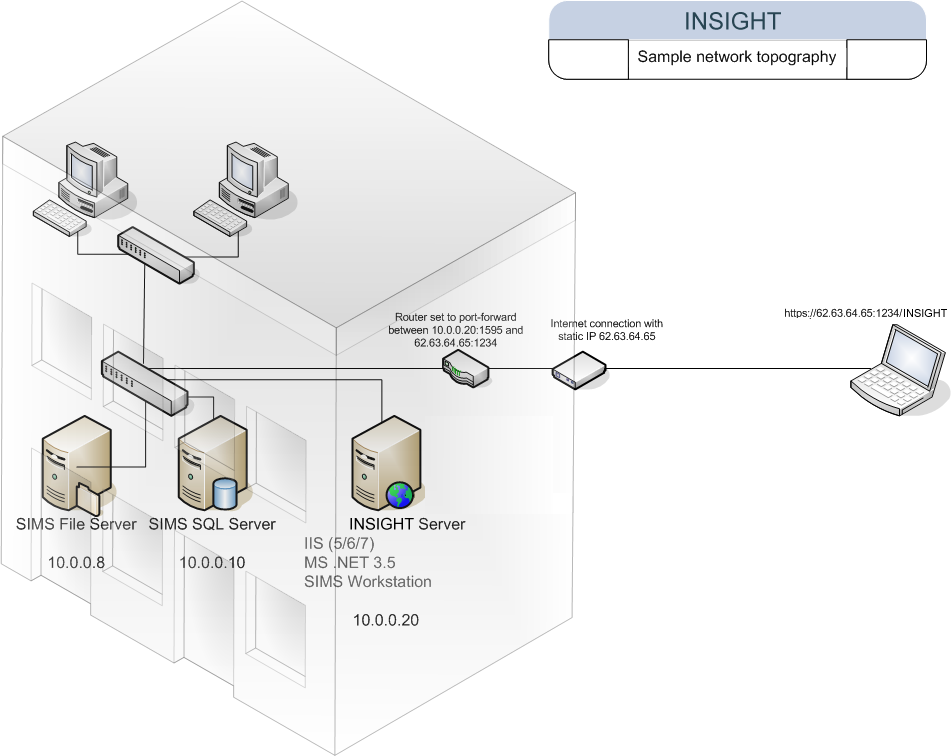Installation
Contents
Prerequisites before installing INSIGHT::-
You will need to install Insight onto a Web Server with Microsoft Internet Information Services (IIS) and Microsoft.Net Framework 4.0 installed, and the SIMS workstation framework. The local CONNECT.INI file in %Program Files%\SIMS\SIMS .net additionally must not be a 'redirect' type - it must be and 'end-point' type, explicitly specifying the server instance and database name. If you are using IIS7 or IIS7.5, please ensure the following features are present:
Web Server
- Common HTTP Features
- Static Content
- Default Document
- HTTP Errors
- HTTP Redirection
- Application Development
- ASP .NET
- .Net Extensibility
- ASP
- ISAPI Extensions
- ISAPI Filters
- Security
- Windows Authentication
- Management Tools
- IIS Management Console
- IIS Management Scripts and Tools
- IIS 6 Management Compatibility
- IIS 6 Metabase Compatibility
NOTE: It is important that on the IIS server the order of installation is Windows -> Webserver software -> .net software
Installing INSIGHT:
- Browse to http://tascsoftware.com/web/
- Log in using supplied username and password
- Click Downloads
- Under Product:INSIGHT select Insight (latest version) and click 'run'
- You will see a license agreement which you must accept to proceed. Following acceptance, the package files will be extracted.
- The following window will briefly appear as pre-requisites are checked:
- If all pre-requisites have been met then main Service Controller window will open. You can also view the Service Controller using \\simscentralservername\SIMSROOTFOLDER\SIMS\INSIGHT from now on (i.e. when you update).
The Service Controller is the program used to actually install the Insight database, and the web site or sites. There are a number of nodes on the left hand side, each revealing a page with a specific purpose in mind. In general, you should work from the top button down in turn.
- Data tier node: In here you will need to direct the service controller to a SIMS connect.ini file. Depending on the rights associated with your login you may have to enter the SQL server's username and password (this is not your Insight/SIMS password or your Windows login). Once the correct details have been added the service controller will display a successful login message.
- Then, click on the Application tier node to configure a website. You can either use one of the existing web sites listed in the left hand panel, or add a new site. If you add an new site you will be asked to specify the site name, the listening port (This port should not collide with any existing sites or services.), and an SSL certificate if any such are present (or choose (none) if you are to be installing this at a later date). Additionally, you need to specify a folder on the IIS server where the application files will be stored. It is important to choose a location that the IIS user (NetworkService) will have permissions to read. It is recommended to create a folder called INSIGHT inside inetpub\wwwroot.
Once you have chosen your site, you can add an application to that site. There are no options for this stage.
- Then, click on the SIMS node where you will need to specify some SIMS usernames and passwords which Insight will use internally. These do not need to have any SIMS .net permissions set, although they do need to exist. Use the Add and Remove buttons to manage the SIMS users. Normally, only between one and three users will be required, dependant upon expected load. A warning - the passwords are not tested at this stage, so if you want to enter them here now and create them later you can, but type carefully if the users you enter here do already exist.
- Then, click on the Commit node. You will have options to:
- Select a theme.
- Choose an image to use as a logo, which must be in the root web folder (INSIGHTFOLDER), and will override any logo stored in SIMS.
- enable a link to PARS,if in use.
- An API can be enabled which can allow external applications to read data from Insight.
You will then be able to commit your selections to the application by clicking the Begin button. This same process will need to be performed each time an Insight service pack is downloaded, to apply the changes to the web server.
Following a commit process, a browser window is opened, on the server, to the default starting page of Insight. The first attempt to load Insight following one of these processes can take up to one minute, where it will appear not much is happening, but you should soon see a login page. You will come back to this later and login.
Within the Services node are a pair of Windows services supporting the main application. The Keep alive and SIMS updater nodes allow you to install and configure these Windows services.
Keep Alive service
The Keep Alive service "prods" the web site to keep the application loaded in memory on the web server. To use this feature, click on the Install button, and then, when the service is installed, click on the Start button.
SIMS Update service
This SIMS updater service is there to watch the central SIMS file server for SIMS updates. IF you are using SOLUS3 this service should not be necessary. Because of this requirement to read information from a remote file server, this service must use a network account rather than a local system account. As part of the installation, you will be prompted for a username in the format DOMAIN\username and a password. To use this service effectively it is important that your %windir%\sims.ini file is accurate, having the correct UNC path specified for SIMSSetupsDirectory.
Test Log-in
On the browser window which displayed earlier use the username and password, received by email, to login.
- If the default starting page of Insight does not open it may be because the software referred to in the NOTE at the top of this page has not been installed in the correct order. Fix this as follows:
Go to start -> run and in the Open field box enter %windir%\microsoft.net\framework\v4.0.30319\aspnet_regiis -i
Click Ok (this will re-install the .net software for you)
- If this is your first log on, you will most likely be taken to a 'No license found' page. This screen will prompt you to retrieve a licence. There are two options:
Method 1 (Preferred option) Click on the ‘here’ link to attempt this. If proxy authentication is required, enter your proxy details into the boxes provided and click the "Update" button. Retry until a licence can be obtained.
Method 2 In extreme circumstances, you can also collect a licence key manually. Click on the 'this' link to collect your licence key (a new window will open); in this new window click on Copy to Clipboard. Back in the Unlicenced - Windows Internet Explorer window paste the key in the box under method 2 and click sumbit.
- You can close the browser window once you can log in completely.
Insight Configuration
Preferences
Preferences are set once, and are used identically by all users of the system. The preferences you will want to concentrate on at this stage are:
'Email settings' Insight should be able to email out from your network in order to, for example, remind users of their passwords. To do this it needs information about your SMTP server. You can also set up an address specifically to ‘collect’ replies to outgoing emails. Some SMTP servers will require that the Reply to address of an outgoing email actually exists, so you may have to create either and address or an alias to handle this. Some SMTP servers will need a username and password to authorise before they will send outgoing email, and you can enter these here too. Similarly, other complicated arrangements can be handled by modifying the Port used, and whether the server requires encryption. Please go to Preferences -> Email to add these settings.
'Proxy' You may have had to modify your proxy details in order to download a licence key. If so the settings are displayed here. If not, you should enter any necessary proxy details. Entering DEFAULT for the proxy name will use standard Internet Options from Windows. Otherwise, enter the proxy in the form 10.0.0.1:8090. If your proxy requires authentication, enter the username and password below, and if the authentication is based on domain credentials, enter this here also. Please go to Preferences -> Proxy to add these settings.
'SMS' Insight can use the TextAnywhere SMS gateway or teachers2parents API to send text messages. If you already have an account with TextAnywhere or teachers2parents, enter the authorisation information here. The two providers offer different services. If you are useing TextAnywhere and want replies to outgoing SMS messages to be collected by an email address, enter that address in the ‘Email address for SMS replies’ field. You will also be able to specify a fixed originator string. Please go to Preferences -> SMS to add these settings.
- Once Insight has been fully installed, it will next need to be configured. Please see the GettingStarted guide for further information.
Configuring External Route
When you are happy that your users and preferences are configured, you will need to ensure that a route is configured from outside to the Insight IIS server. Although the details will change according to the environment your Insight server operates in, the principle remains the same. Your school will have a static IP address that it presents to the Internet, and you will have to forward requests to this address, on the port chosen for Insight when installing, to the internal network address of the Insight server on the same port, for example:
Assuming your schools external IP address is 21.22.23.24, and your Insight server's internal network address is 192.168.1.12, and that Insight is installed to listen on TCP port 1590, the forwarding rule would be 21.22.23.24:1590 is to be forwarded to 192.168.0.12:1590.
This rule would normally be configured either at the school's main incoming router, or you may have to put in a change request to your LA to have this facility enabled - again, details will vary according to circumstance.
When you know the external address you will be using, you can either embed this in your schools main web site as a link, or distribute it as is.
As a final note, it is strongly suggested that you install and use an SSL certificate on the Insight server, and also that it is not a self-signed certificate, unless you will be also using the server as a root certificate authenticator.
Although not authoritative, the example below may help you to with this stage.
Where schools are linked via a Grid for Learning Network managed by their Local Authority slightly different procedures may be required. In this case talk to TASC and to your Local Authority Technical Officers.
